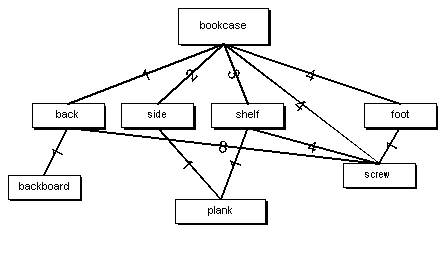The parts explosion problem is a classic application of recursion. In this problem, the components necessary to assemble a particular object are represented by a graph. The goal is to represent this graph using a database table, then to calculate the total number of the necessary elemental parts.
For example, the following graph represents the components of a simple bookshelf. The bookshelf is made up of three shelves, a back, and four feet that are held on by four screws. Each shelf is a board held on with four screws. The back is another board held on by eight screws.

The information in the table below represents the edges of the bookshelf graph. The first column names a component, the second column names one of the subcomponents of that component, and the third column specifies how many of the subcomponents are required.
| component | subcomponent | quantity |
|---|---|---|
| bookcase | back | 1 |
| bookcase | side | 2 |
| bookcase | shelf | 3 |
| bookcase | foot | 4 |
| bookcase | screw | 4 |
| back | backboard | 1 |
| back | screw | 8 |
| side | plank | 1 |
| shelf | plank | 1 |
| shelf | screw | 4 |
Execute the following statements to create the bookcase table and insert component and subcomponent data.
CREATE TABLE bookcase (
component VARCHAR(9),
subcomponent VARCHAR(9),
quantity INTEGER,
PRIMARY KEY ( component, subcomponent )
);
INSERT INTO bookcase
SELECT 'bookcase', 'back', 1 UNION
SELECT 'bookcase', 'side', 2 UNION
SELECT 'bookcase', 'shelf', 3 UNION
SELECT 'bookcase', 'foot', 4 UNION
SELECT 'bookcase', 'screw', 4 UNION
SELECT 'back', 'backboard', 1 UNION
SELECT 'back', 'screw', 8 UNION
SELECT 'side', 'plank', 1 UNION
SELECT 'shelf', 'plank', 1 UNION
SELECT 'shelf', 'screw', 4; |
Execute the following statement to generate a list of components and subcomponents and the quantity required to assemble the bookcase.
SELECT * FROM bookcase ORDER BY component, subcomponent; |
Execute the following statement to generate a list of subcomponents and the quantity required to assemble the bookcase.
WITH RECURSIVE parts ( component, subcomponent, quantity ) AS
( SELECT component, subcomponent, quantity
FROM bookcase WHERE component = 'bookcase'
UNION ALL
SELECT b.component, b.subcomponent, p.quantity * b.quantity
FROM parts p JOIN bookcase b ON p.subcomponent = b.component )
SELECT subcomponent, SUM( quantity ) AS quantity
FROM parts
WHERE subcomponent NOT IN ( SELECT component FROM bookcase )
GROUP BY subcomponent
ORDER BY subcomponent; |
The results of this query are shown below.
| subcomponent | quantity |
|---|---|
| backboard | 1 |
| foot | 4 |
| plank | 5 |
| screw | 24 |
Alternatively, you can rewrite this query to perform an additional level of recursion, and avoid the need for the subquery in the main SELECT statement. The results of the following query are identical to those of the previous query.
WITH RECURSIVE parts ( component, subcomponent, quantity ) AS
( SELECT component, subcomponent, quantity
FROM bookcase WHERE component = 'bookcase'
UNION ALL
SELECT p.subcomponent, b.subcomponent,
IF b.quantity IS NULL
THEN p.quantity
ELSE p.quantity * b.quantity
ENDIF
FROM parts p LEFT OUTER JOIN bookcase b
ON p.subcomponent = b.component
WHERE p.subcomponent IS NOT NULL
)
SELECT component, SUM( quantity ) AS quantity
FROM parts
WHERE subcomponent IS NULL
GROUP BY component
ORDER BY component; |
 |
Discuss this page in DocCommentXchange.
|
Copyright © 2012, iAnywhere Solutions, Inc. - SQL Anywhere 12.0.1 |